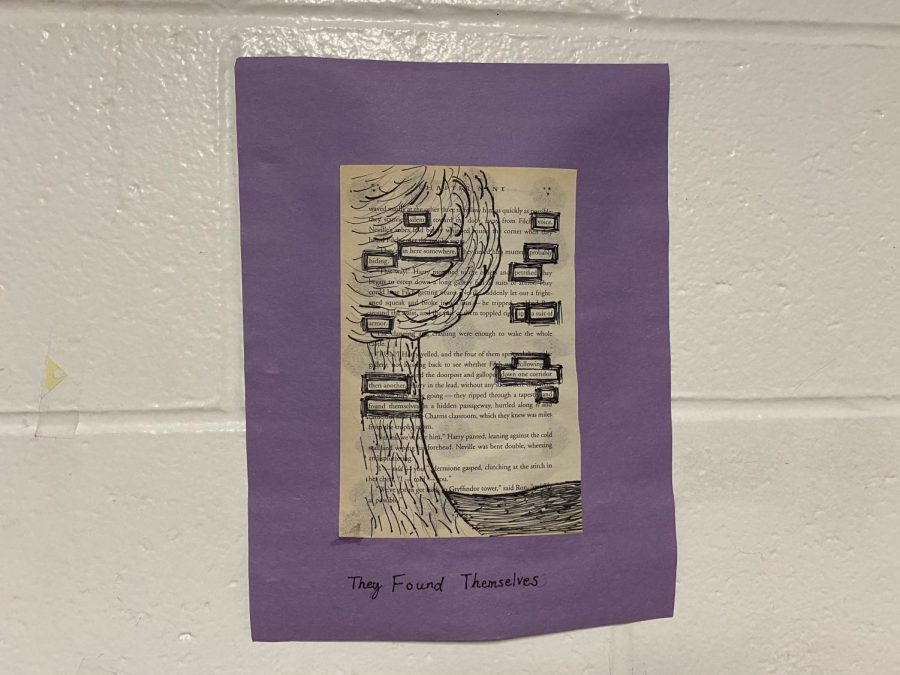The halls of FHC tell the stories of the students who have found their paths through them

More stories from Natalie Mix
One of the many pieces of blackout poetry plastered around the school
English teachers Kelli Potts, Anne Keller, and Ken George can agree on one sentiment definitively: the walls of Forest Hills Central High School have always needed a little spicing up.
In an environment filled with the color and vivacity that the student body creates, they each individually expressed a desire to take that life and transfer it to the physical aspect of the building.
For George, that meant capturing the smiling faces that roamed the halls every day and putting them to photos that would remain long after those students had taken their final steps through the doors of their high school.
“It was a few years ago,” George said, “and I was walking through the hallways, looking at the hospital-esque white walls, and I think it was in the midst of a time when I was talking a lot with Ms. Stiles and Mr. Anderson about school pride and school spirit and thought, ‘It’s weird that [we] just have these blank walls.’”
Inspired by photos he’d seen displayed in another high school, George spearheaded a project that remains an integral piece of the hallways now. Working with Tricia Donovan, who took a majority of the photos and facilitated the printing process, and a few students, who contributed to actually mounting the photos after school, George paved the path for generations of students to become memorialized on the walls.
Desiring to genuinely display the diversity of the student body and its interests, the photos depict scenes from sports games to theatre productions to celebrations of school pride.
“We tried to capture the wide variety of opportunities available here,” George said. “We also tried to capture emotion connected to school, like when someone was passionate about something.”
Ranging from alumni four years back to current high school seniors, and even beyond that, the photos serve to remind current high school students of the grades that came before them, but George is actively working towards updating the photos to properly represent the student body now.
He recalls the excitement that these photos initially evoked amongst the student body as they searched the halls for the familiar faces of their friends, classmates, and even themselves, and he hopes to achieve that energy once again.
“Early on, like the day after we put them up, it was really fun in school,” George said. “Everyone was stopping and looking at all of them, [but] the problem now is [that] it’s so weird how quickly they look old. They look like people that are not here now, and they’re not.”
The ongoing and ever-evolving nature of this project provides a permanent variety to the halls, but on the other hand, Keller and Potts took more temporary approaches, ones that represented the current group of students in their classes: displaying the recent activities their students had completed.
For Potts’ Honors English 9, this project was blackout poetry.
In conjunction with her unit on Long Way Down by Jason Reynolds—a book that focuses on the subset of societal issues that the main character faces—Potts directed her students to write blackout poetry based on a societal issue that affected them within Forest Hills Public Schools.
From concepts like identity to academic pressure, Potts was proud of the depth and creativity that her students infused into their poems, and she was thrilled to hear their voices in this unique fashion.
“I think what’s great about blackout poetry is that the words are on the page for you,” Potts said. “You’re not creating your own words, but you’re using your voice because you’re picking the words that matter most to you. I love that concept.”
While she received sporadic feedback from students who mentioned seeing other students reading the poetry in the halls, Potts received even more feedback from teachers, who have applauded both the aesthetic and visual ingenuity of the poems and the emotionally rich opportunity for students to write what they’re passionate about.
Potts even shared some of her favorite poems, anonymously, of course, on her Instagram story.
Spicing up the cinder-block walls was an added bonus to proudly displaying her students’ stellar work.
“I think it’s good to have things on the walls for kids to be looking at,” Potts said, “and it just added some color, and it added, obviously, student voice to the walls, which is great cause they created them. So I hope kids have stopped and looked at a couple of them because they’re really good.”
When it comes to providing entertainment between classes, Keller hit the mark with the projects that her Senior Composition and AP Lang students completed.
In the time that these eye-catching posters have been hanging above the lockers outside her room, she’s overheard various bits of intriguing conversation, and understandably so. The projects revolve around a phenomenon entitled “Fat Bear Week.”
“Every year, [there’s this] thing called Fat Bear Week,” Keller said. “It’s an actual event, and there are these bears that are really fat, and the public can vote on who should win Fat Bear Week. You look at what they eat and how they interact with other bears and their survival and all that kind of stuff. So [my students] had to research these bears, and then they had to argue that their bear should be voted for the fattest bear.”
Designed to help her students expand their argument-building skills, the project required them to not only employ a visual argument on their posters but also to verbally communicate their points in a presentation to the class.
After the presentations, Keller’s students voted for the soundest argument. Regardless of winning status, all of the bears were proudly displayed in the hallway—a definite conversation starter.
“I feel like, sometimes, the halls here could use a little more showcasing of student work and something that engages your mind,” Keller said. “A lot of students, I think, enjoy it. As they walked through, I heard them say, ‘Oh, look at that one. That one’s amazing.’ We have some really talented, visual students.”
Keller ran into a peculiar issue while devoting a notable portion of time to featuring her students’ work in the hallway: nothing sticks to the cinder block walls. She wasn’t alone in this conflict; Potts utilized an excess of varying kinds of tape to hold her students’ poetry up, and George had a nearly opposite issue—the few photo prints he removed a few years back took a little bit of the wall with them.
“I spent actually an odd amount of time looking for adhesive that would work on cinder block walls,” Keller said. “I researched that, and it’s a constant struggle for how to hang things up because they always fall off. I found these sticky clips, and I ordered them, and I thought they worked pretty well. Most of the posters stayed up for a good, long time, longer than I think poster putty would do.”
This unique conundrum, on top of the weekend hours that Keller spent attaching “fat bear” posters to the walls, is proof of the fact that displaying student work is often no easy feat. Both Potts and George can speak to that as well—from theorizing and experimenting with different adhesives to sacrificing their own time to show their students the impact their presence and art can have.
But ultimately, the strain is worth it. Keller herself loves to traverse the halls and see what other classes are engaged in, the art that they are creating. She believes that this sharing and collaboration of ideas is beneficial for the students as well—by inspiring their own work and providing color to the occasional monotony of the school day.
“I think as much as you can showcase student work, the better it is,” Keller said. “It doesn’t all have to be displayed, and sometimes, it’s hard to display things, but if you have something that you can share, that’s definitely worthwhile. And I think it gives students pride when they see their work hanging up.”

Natalie Mix is a senior taking on her fourth and final year as a member of The Central Trend. Room 139/140 and the staff of The Central Trend have been...



























































































